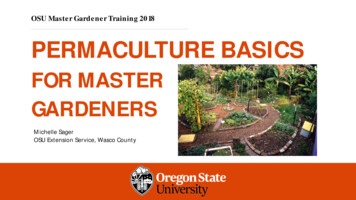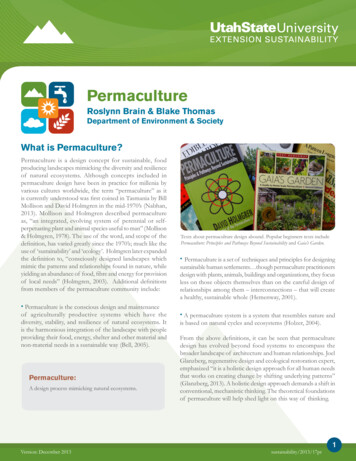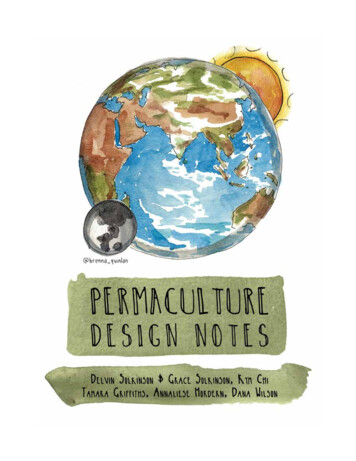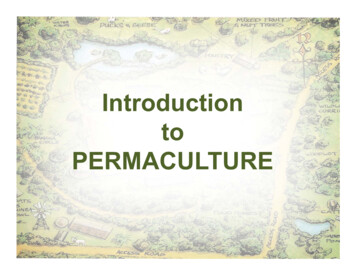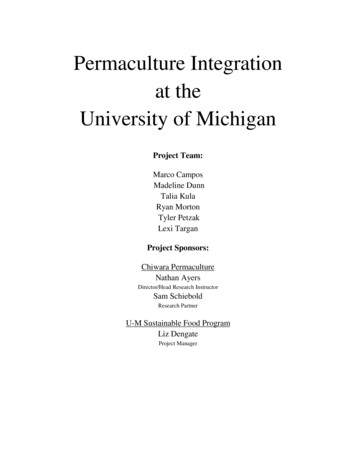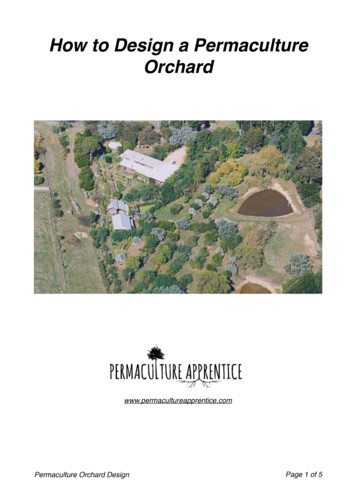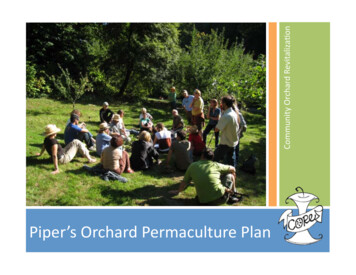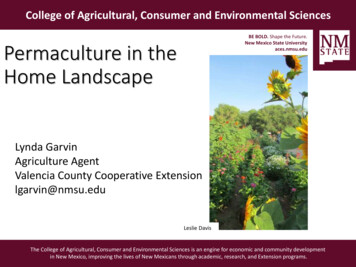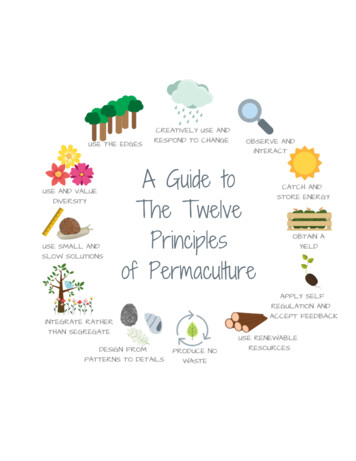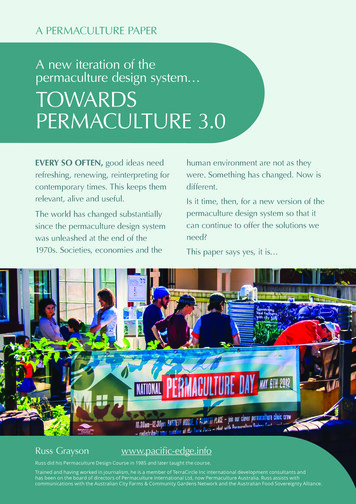
Transcription
A PERMACULTURE PAPERA new iteration of thepermaculture design system TOWARDSPERMACULTURE 3.0EVERY SO OFTEN, good ideas needrefreshing, renewing, reinterpreting forcontemporary times. This keeps themrelevant, alive and useful.The world has changed substantiallysince the permaculture design systemwas unleashed at the end of the1970s. Societies, economies and theRuss Graysonhuman environment are not as theywere. Something has changed. Now isdifferent.Is it time, then, for a new version of thepermaculture design system so that itcan continue to offer the solutions weneed?This paper says yes, it is www.pacific-edge.infoRuss did his Permaculture Design Course in 1985 and later taught the course.Trained and having worked in journalism, he is a member of TerraCircle Inc international development consultants andhas been on the board of directors of Permaculture International Ltd, now Permaculture Australia. Russ assists withcommunications with the Australian City Farms & Community Gardens Network and the Australian Food Sovereignty Alliance.
ContentsA new permaculture for a changed world . . . . . . . . . . . . . . . . . . . . . . . . . . . . . . . . . . . . . . . . . . . . . . . . . . . . . . . . . . . . . . . . . . . . . . . . . . . . . . . . .3A new version of Permaculture? Why? . . . . . . . . . . . . . . . . . . . . . . . . . . . . . . . . . . . . . . . . . . . . . . . . . . . . . . . . . . . . . . . . . . . . . . . . . . . . . . . . . . . . . . .7A new vision — Permaculture version 3.0. . . . . . . . . . . . . . . . . . . . . . . . . . . . . . . . . . . . . . . . . . . . . . . . . . . . . . . . . . . . . . . . . . . . . . . . . . . . . . . . .9Element 1: Permaculture is a platform. . . . . . . . . . . . . . . . . . . . . . . . . . . . . . . . . . . . . . . . . . . . . . . . . . . . . . . . . . . . . . . . . . . . . . . . . . . . . . . . . . . . . . .11Element 2: Replace ‘sustainability’ with ‘resiliency’ . . . . . . . . . . . . . . . . . . . . . . . . . . . . . . . . . . . . . . . . . . . . . . . . . . . . . . . . . . . . . . .13Element 3: Position permaculture as a design system. . . . . . . . . . . . . . . . . . . . . . . . . . . . . . . . . . . . . . . . . . . . . . . . . . . . . . . . . . . .15Element 4: Avoid technophobia. . . . . . . . . . . . . . . . . . . . . . . . . . . . . . . . . . . . . . . . . . . . . . . . . . . . . . . . . . . . . . . . . . . . . . . . . . . . . . . . . . . . . . . . . . . . . . . . . . . .16Element 5: Adopt systems thinking . . . . . . . . . . . . . . . . . . . . . . . . . . . . . . . . . . . . . . . . . . . . . . . . . . . . . . . . . . . . . . . . . . . . . . . . . . . . . . . . . . . . . . . . . . . . . .18Element 6: Move beyond ‘peasant permaculture’ . . . . . . . . . . . . . . . . . . . . . . . . . . . . . . . . . . . . . . . . . . . . . . . . . . . . . . . . . . . . . . . . . . . .20Element 7: Make knowledge open source . . . . . . . . . . . . . . . . . . . . . . . . . . . . . . . . . . . . . . . . . . . . . . . . . . . . . . . . . . . . . . . . . . . . . . . . . . . . . . . . . .22Element 9: Strengthen the networked structure. . . . . . . . . . . . . . . . . . . . . . . . . . . . . . . . . . . . . . . . . . . . . . . . . . . . . . . . . . . . . . . . . . . . . .25Element 10: Build a community of practice.26Element 11: Set standards for permaculture work . . . . . . . . . . . . . . . . . . . . . . . . . . . . . . . . . . . . . . . . . . . . . . . . . . . . . . . . . . . . . . . . . . .27Element 12: Adopt a science-based approach. . . . . . . . . . . . . . . . . . . . . . . . . . . . . . . . . . . . . . . . . . . . . . . . . . . . . . . . . . . . . . . . . . . . . . . . . . .29Element 13: Adopt a social entrepreneurial approach. . . . . . . . . . . . . . . . . . . . . . . . . . . . . . . . . . . . . . . . . . . . . . . . . . . . . . . . . . . .32Element 14: Develop partnerships and collaborations. . . . . . . . . . . . . . . . . . . . . . . . . . . . . . . . . . . . . . . . . . . . . . . . . . . . . . . . . . .33Element 15: Introduce a culture of evaluation. . . . . . . . . . . . . . . . . . . . . . . . . . . . . . . . . . . . . . . . . . . . . . . . . . . . . . . . . . . . . . . . . . . . . . . . .34Element 16: Adopt sustainability education criteria . . . . . . . . . . . . . . . . . . . . . . . . . . . . . . . . . . . . . . . . . . . . . . . . . . . . . . . . . . . . . . .36Element 17: Diversify and adapt the PDC . . . . . . . . . . . . . . . . . . . . . . . . . . . . . . . . . . . . . . . . . . . . . . . . . . . . . . . . . . . . . . . . . . . . . . . . . . . . . . . . . .38Element 18: Adopt simple structures . . . . . . . . . . . . . . . . . . . . . . . . . . . . . . . . . . . . . . . . . . . . . . . . . . . . . . . . . . . . . . . . . . . . . . . . . . . . . . . . . . . . . . . . . .40Element 19: Address contemporary lifestyles . . . . . . . . . . . . . . . . . . . . . . . . . . . . . . . . . . . . . . . . . . . . . . . . . . . . . . . . . . . . . . . . . . . . . . . . . . .42Element 20: Scale-up permaculture. . . . . . . . . . . . . . . . . . . . . . . . . . . . . . . . . . . . . . . . . . . . . . . . . . . . . . . . . . . . . . . . . . . . . . . . . . . . . . . . . . . . . . . . . . . .45Element 21: Introduce greater focus on people skills . . . . . . . . . . . . . . . . . . . . . . . . . . . . . . . . . . . . . . . . . . . . . . . . . . . . . . . . . . . . .46Element 22: Develop project skills . . . . . . . . . . . . . . . . . . . . . . . . . . . . . . . . . . . . . . . . . . . . . . . . . . . . . . . . . . . . . . . . . . . . . . . . . . . . . . . . . . . . . . . . . . . . . .47Element 23: Focus more on medium density living . . . . . . . . . . . . . . . . . . . . . . . . . . . . . . . . . . . . . . . . . . . . . . . . . . . . . . . . . . . . . . . . .48Element 24: Create a strong urban focus . . . . . . . . . . . . . . . . . . . . . . . . . . . . . . . . . . . . . . . . . . . . . . . . . . . . . . . . . . . . . . . . . . . . . . . . . . . . . . . . . . .49Element 25: Move beyond the designer-led approach . . . . . . . . . . . . . . . . . . . . . . . . . . . . . . . . . . . . . . . . . . . . . . . . . . . . . . . . . . . .51Element 26: Adopt the collaborative economy . . . . . . . . . . . . . . . . . . . . . . . . . . . . . . . . . . . . . . . . . . . . . . . . . . . . . . . . . . . . . . . . . . . . . . . . .52Element 27: Towards a social permaculture . . . . . . . . . . . . . . . . . . . . . . . . . . . . . . . . . . . . . . . . . . . . . . . . . . . . . . . . . . . . . . . . . . . . . . . . . . . . . .52Element 28: Work with those who want to learn and work where it counts . . . . . . . . . . . . . . . . . . . .562A Permaculture Paperwww.pacific-edge.info
A new permaculture for a changed worldTHE WORLD WE LIVE IN NOW is not the worldpermaculture was born into. Nor is it the world in whichpermaculture spent its adolescence and in which itgrew to maturity. Things have changed and we needto engage the world as it is now, and that might meandoing what we do a little differently.Permaculture needs to change to adapt to contemporaryconditions so as to remain relevant. It has to competefor attention in the public marketplace for ideas andthat, today, is a crowded and busy marketplace.Permaculture is said to use nature as an inspiration forits works. Nature’s patterns and structures are thereforea model for the way that permaculture designers thinkabout things.MotivationTo do this requires adaptation — evolution, that is.My motivation for proposing a Permaculture Version 3.0is to see the permaculture design system upgraded so asto position it as an intellectual and practical technologythat can be safely adopted by individuals, communities,local government and other institutions.Permaculture evolves tooEvolution is one of these patterns of nature. It is atemporal pattern that shapes the lifeforms around usand that shapes us — humanity. This implies that itMy background for making the proposals in thispublication come from my experience in permaculture.I did my permaculture design course (PDC — ledby permaculture educator, Robyn Francis) in 1985and followed this with experience in communityorganisations, international development NGOs, socialenterprise and local government, in addition to teachingthe PDC as a member of the Sydney permacultureteaching team through the 1990s.must be one of those properties of nature that we, aspermaculture designers, reflect in our design.(permaculture). has tocompete for attention inthe public marketplaceThis has brought close contact with local governmentstaff, with social enterprise specialising in fooddistribution, with community-based organisationsand with a national food sovereignty educational andadvocacy team.for ideas and that, today,is a crowded and busymarketplace.For one of those social enterprises, Sydney FoodConnect, I operated a weekly City Cousin depot wheremembers collected their box of fresh, organic foodproduced for the most part by Sydney region farmers. Agood thing about Sydney Food Connect was that it wasthe creation of a graduate of the Permaculture DesignCourse, and the good news for me was that he was agraduate of one of our own Urban Permaculture DesignCourses. Ooooby (Out Of Our Own Back Yards),another community-supported agriculture enterprise,took over Sydney Food Connect’s operation when thedirector had to move on.It makes sense that not only ought we consider evolution— how things change over time — in our design work,we need to apply it to the permaculture design systemsas a whole and realise that it, too, changes.Organisms, technology and ideas themselvesdemonstrate evolution in that they change to maintainwhat in evolutionary studies is called ‘fitness forpurpose’. Permaculture practitioners would do well, Ibelieve, to understand that permaculture, in order toadapt to changing world conditions and to maintainits fitness for purpose, must change too. Just as naturediscards old forms no longer the best fit for purposein a changing environment, so too must permaculturediscard the old and less effective and adopt new, timelyideas and practices.I’ve had the good fortune to work with PDC graduateson a project steering committee. They work inarchitecture, landscape architecture and in sustainabilityeducation roles in both business and local government,and they have integrated permaculture’s ethics,3A Permaculture Paperwww.pacific-edge.info
A need to monitor and evaluateprinciples and concepts into their working lives. Theirwork creates the credibility that permaculture needs inmainstream society because it is visible to the publicand local government and because people regularlymake use of it. Their work normalises permaculture.It is difficult to track the evolution of permaculture andthe roles it fills in society because there is no substantivepractice of monitoring and evaluation within the designsystem through which we can track progress, redressdifficulties and build a picture of the design system atany time. The closest we have come to this was a surveyconducted by Permaculture Australia in 2014.That’s not to say that other permaculture individuals,associations and educators do not similarly contributeto the design system’s good image, however for themost part their contribution is as a voluntary communityactivity. This is valuable, of course, because it is activityof this type that sustains permaculture as a popularpractice.Coming from an international development consultancybackground where monitoring and evaluation are partof the normal project cycle, this seems an omissionthat could stymie organisational learning. Sure,there is opinion but in my experience the opinion ofpermaculture practitioners usually claims that the designsystem is moving forward in great bounds, yet thoseopinions are seldom based on objective data.Over the years I have gained insight into howpermaculture is perceived by those outside of it andhow permaculture practitioners see themselves and theirroles. Often, there’s a disconnect.With the availability of Accredited PermacultureTraining (APT) — what is in effect nationally recognisedworkplace education — developing permaculture asa livelihood option becomes important, and to dothis the credibility and reputation of the design systemcount for much. This makes improving the perceptionof permaculture among professionals and government anecessary component of a proposed new iteration of thepermaculture design system—Permaculture Version 3.0.Ideas absorbedAnother comment, from an educator, was that muchof what is taught in permaculture and what wereonce its innovative ideas are now taught in tertiaryenvironmental management and science courses.It’s that mainstreaming process again, ideas spinningin from the innovative edge to the mainstream coreas described by Roger’s Ideas Diffusion model. Whatthis means for permaculture educators is that PDCparticipants are now likely to be better educated andmore critical of what they learn in a design course.In my work in local government and elsewhere, I havefound that permaculture people and ideas have beenabsent when they should have been present. Goodideas, what you would expect from permaculturepeople, have come from those with no links tothe design system at all. Perhaps this demonstrateshow what once was cutting-edge thinking has beenmainstreamed.ChallengesAn influence on thinking about a new iteration of thepermaculture design system comes from the periodicresurfacing of a long-running conversation withinthe permaculture education milieu — whether theLeading questionsPermaculture Design Course remains fit for purposeand whether permaculture education needs a morediversified, nuanced approach to educating people toact in a world substantially different to that for which thePDC was originally devised.Someone who has had much to do with thepermaculture design system asked whetherpermaculture has lost its innovative edge because muchof the permaculture conversation is about topics, ideasand technologies that are today mainstream.Then there was the question and the challenge severalyears ago that came from social entrepreneur, MitraAadron, who said that permaculture, though a goodidea, would have to scale-up its work to remain relevantto the realities of contemporary times. He challengedpermaculture people to do this. Unfortunately, noneaccepted his challenge. It was Mitra’s work that gave hisproposal credibility and relevance.If contemporary permaculture practice does not engagewith the big issues facing us today there is a chance thatperson’s question could be answered in the affirmative.What he asked was whether permaculture had becomestale, its ideas and practices no longer on the socialcutting edge from where those that are successful spinin towards social acceptance and adoption.4A Permaculture Paperwww.pacific-edge.info
Yet another factor influencing the idea for a newversion of permaculture has been watching it becomea respectable term in a still far too small number of citycouncils. This is an uncommon phenomenon and it isthe work of a very small cadre of permaculture educatedand motivated people gaining positions in council. Asone put it: “Five years ago I couldn’t have used the word‘permaculture’ in my work. Now I can. That’s change,but it’s still not true in most councils”.to perceive it as a way to make mulched gardens.Educators commonly focus on sustainability areaslike energy, water, waste and transport, and a fewhave adopted food security and food production.Sustainability education is an influential professionthat has perhaps been inadequately targeted bypermaculture organisations and educators.In another example of permaculture becominginstitutionally acceptable, in Randwick, in Sydney’sEastern Suburbs, council sustainability educator, FionaCampbell, was able to use state government grant fundsto create the Permaculture Interpretive Garden, a hybridpublic park and council education facility, and to retrofitfor energy and water efficiency a community centre,install sustainability educational features and offercourses in community resilience.Permaculture is frequently missing in public affairsand advocacy around sustainability and urbanissues. Educators and practitioners talk about urbanfood security or food sovereignty but there are fewpermaculture people active in the work of organisationssuch as the food sovereignty and food security alliancesaround the country.A question of perceptionsContributing to this is what I see as a disconnectbetween the hands-on growing of food and the bigpicture need to see that farming in Australia has a goodfuture and that all have adequate access to nutritiousfood and can exercise their freedom of choice inselecting the type of food they prefer.I have seen this partial acceptance of permaculture in asector I once worked in — international development.There, some years ago, I witnessed a governmentadviser assuring a meeting that permaculture “has noplace in overseas development assistance”. I also sawpermaculture ideas become part of the work of a smallnumber of agencies. The adviser saw permaculture as alargely derivative approach based in other, establishedapproaches to farming systems and, thus, offeringnothing new or of value.An outcome of this is that those active in advocacy andeducational organisations can see permaculture as onlya minor player without much to contribute. It is seen asa small scale approach to food security, valuable, butnot addressing the food security and food sovereigntyof those who cannot grow some of what they eat. Thatis an economic and policy question and permaculturecan sometimes be seen as not addressing those types oftrends that are so critical to our fair food future.A question of credibilityPermaculture’s absence from important work roused mycuriosity as to why this is so.Needed: a better definition of doingThe answer has to do with the perceived credibility andthe niche in society occupied by the design system.Frequently, local government and design professionalssee permaculture as an amateur, garden-orientedpractice lacking the rigour and structure of professionalwork. They see it as poorly finished and ignoringlanduse planning and regulatory criteria. The idea of itas a design system integrating the elements of resilientliving has been lacking. I put this down, in part, to theabsence of resiliency as a criteria in their work.I understand that there’s a philosophy of ‘doing’ thatremains influential within permaculture, howeverthis philosophy is often narrowly interpreted as doingphysical things like making a vegetable garden.‘Making’ is very important because it is how we bringgood ideas into existence, however the definition ofmaking needs to be broadened to working with thebrain as well as the hands and to working in advocacy.The reality is that it is the intellectual work that usuallysets the parameters of the possible and shapes ourfuture.Likewise, local government sustainability educatorsmight on occasion pay lip service to permaculturebut commonly have a very limited concept of thedesign system and its potential role in society, and theopportunities it would offer to their work. Most seemWhat I have left unexplored here are the myriad positiveinfluences in which I have seen permaculture work well.5A Permaculture Paperwww.pacific-edge.info
Iteration not revisionPermaculture. an ethicalIn proposing a new version of the permaculture designsystem I propose an iteration, not something completelynew that would replace that existing. Some of the ideas Ipropose already exist here and there and could be builtupon.design tool, creatingsustainability through theintegration of diversity,stability and resilienceEvolution requires provocation to work, whether thatprovocation is a changing climatic system forcingadaptation by plants, animals and people or whether itis competitive pressures within the public marketplacefor ideas forcing organisations to adapt to changingsocial, environmental and economic circumstances.in ecologically sound,economically viable humanenvironments respectingthe whole of creation.Adaption to change — it should come naturally topermaculture because change is what the design systemis all about.Dawn ShinerAustralian permaculture practitioners at Australasian Permaculture Convergence 11 in Turangi, New Zealand.Permaculture College Australia’s Robyn Francis is at left in the striped top. In the yellow top is Permaculture Macarthur’s SueMossman. Annaliese Horden, from northern NSW, holds the sign at right of photo while sustainability educator, Fiona Campbell,peers from behind her. Transition Bondi’s Lance Lieber looks over shoulders at centre rear. The author is at left of frame.6A Permaculture Paperwww.pacific-edge.info
A new version of Permaculture? Why?This is something that was reinforced for me as a staffmember of a city council. There, in local government,I found that design professionals and decision makersremained largely ignorant of permaculture even thoughsustainability educators working in councils occasionallyoffered workshops in it.IT’S GETTING ON FOR 40 YEARS since permaculturewas born with the publication of the book, PermacultureOne1, in 1978. The work of the permaculture designsystem’s originators, Bill Mollison and David Holmgren,the book conceptualised a new world view and asolution to the social, environmental and economicconcerns of the time.A new iterationPermaculture, as broadly described in Permaculture Oneand, the following year, Permaculture Two2, seemed tooffer a way forward, a new way to think about what washappening and how we could best react to that through adesign-based approach. It reframed the opposition of thelobby groups of the time as a constructive and proactiveapproach to creating what it was we wanted to see.To state it briefly, a new iteration of permaculture maybe timely because:mmthe world has changed substantially from thetime of permaculture’s birth (taken as the year ofpublication of Permaculture One in 1978) and theformulation of the Permaculture Design Course inthe early years of the following decade; there arenewer priorities in sustainability, much research,development and deployment of sustainabilitytechnologies and there are people educated attertiary level now making careers in sustainabledevelopment and sustainability education; all ofthis affects permaculture’s futureOver succeeding years the permaculture idea spreadworldwide and, like plants and animals do, it speciated.It evolved into different lines of thought, focusing ondifferent themes in different places at different times.Today, permaculture is a diverse practice in city andcountry.Even though the focus and practice of permaculture haschanged over time, there is a notion that after nearly fourdecades the design system could do with a makeover.not to change its core ethics, principles and conceptsbut to update and reiterate it for the contemporary worldand to change how it is conceptualised, taught andimplemented.mmthe sustainability movement has diversified andtoday ideas and organisations compete for people’stime and effortmmthere is now an acceptance that humanity and theEarth are entering a new epoch popularly knownas the Anthropocene (the Age of Humanity) andthat this is the result of the Great Accelerationin resource extraction and consumption, wasteproduction, atmospheric heating, oceanicacidification, native and agricultural biodiversitydecline, science and technological knowledge,communications, international travel, urbanand economic growth, all of which started theacceleration in the mid-1950s and that continuestodaymmhumanity’s influence on earth systems such asatmosphere, oceans, soils and land, wildlifepopulations, landuse and more are regarded asbeing of the same order of magnitude as a force ofnature; this means that humanity now substantiallyinfluences the earth system that we have evolvedwith and that made possible the diversity of humancultures and civilisations.Making more of the design systemI think David Holmgren summed up permaculture’ssuccess when he said that the design system has evolvedmainly as technology of the household and voluntarycommunity sector.Having now attained a level of public acceptance,forward thinking permaculture practitioners want to makemore of the design system and to take it into the domainsof social institutions and workplace situations. If we areto do this then we have to strengthen permaculture’scredibility by upgrading its standards of practice so that itbecomes acceptable to decision makers working in thosedomains.11978; Mollison B, Holmgren D; Permaculture One, TagariPublishers, Tasmania.21979, Mollison B ; Permaculture Two, Tagari Publishers, Tasmania.7A Permaculture Paperwww.pacific-edge.info
Adapting to the Great AccelerationIt is an opportunity because the naming of a newepoch throws open our minds to the scale of thehuman enterprise and its influence, and encouragesus to rethink what we believe and what we do. In thatquestioning may be new avenues for permaculture indeveloping new solutions that can be multiplied throughadoption and adaptation by people elsewhere.It is the momentum of the Great Acceleration intothe Anthropocene that throws up the challenge topermaculture.The naming of a new epoch, even if only unofficiallyat the time of writing (geologists and others aredeliberating it) is both a challenge and an opportunityfor permaculture.Permaculture needs to come to terms with these andother trends by broadening its ambit and engaging withcompatible organisations, and by adopting for its ownbenefit new ideas and approaches, some of which youwill find in the following pages.It is a challenge because it poses issues of global scalethat permaculture, primarily acting locally through smallprojects, might find difficulty in providing scaled-upsolutions to that can be widely adopted.8A Permaculture Paperwww.pacific-edge.info
A new vision — Permaculture version 3.0Permaculture 2.0LET’S THINK about the evolution of the permaculturedesign system as consisting of three phases.Permaculture Version 2.0 spans the years from themid-1980s, when that first batch of recruits went outto spread the word through their own courses, and onto the present day. It can be seen as permaculture’schildhood and early adulthood.I use a ‘version’ numbering convention, brought overfrom digital culture, as it is nowadays common and isused to identify new versions of a technology (heredefining permaculture as an intellectual and practicaltechnology).Over those years the design system grew, wentalong different paths for a time and attracted a largerfollowing. In terms of the Diffusion of Ideas model,those years saw permaculture spread from the earlyadopters into the early mass adoption phase.Permaculture 1.0We can think of the first phase—Permaculture Version1.0—starting with the publication of PermacultureOne in 1978 and going forward into the first half of the1980s.The period also brought new ideas into permacultureand some became part of the PDC offerings ofeducators. Permaculture practice diversified aseducators and practitioners set off down new roadslike permaculture in international development,permaculture in schools, ecovillage development andothers.Permaculture Version 1.0,then, can be envisioned asspanning the years from1978 through to aroundIt was mainstream media that played an importantrole in the latter period of Permaculture 2.0, from thelate-1980s, on through the 1990s and on to today. Sotoo did permaculture’s own media. Print magazines likePermaculture International Journal, Permaculture Edgeand local permaculture newsletters like PermacultureSydney’s Winds of Change spread news of the designsystem in the 1990s.1985 and being made up ofthe innovators and the firstbatch of people attracted tothe design systemLooked at in terms of Everett Rogers Diffusion ofInnovation3 model, we see the idea starting withpermaculture’s inventors — David Holmgren andBill Mollison — then spreading to the first coterie ofrecruits who, through a variety of means got to hear ofpermaculture, thought it a good idea and wanted to bepart of it. They attended the first of the permaculturedesign courses then went on to teach the course.Permaculture 3.0How, when and if permaculture begins its journey intoPermaculture Version 3.0 remains to be seen. Whatwould this phase bring to the evolution of the designsystem?First, it would accompany the movement ofpermaculture into a later stage of mass adoption. Itwould hopefully see greater acceptance of permacultureas a design system among professionals such as urbanplanners, land managers, social planners and thoseworking in local government.Permaculture Version 1.0, then, can be envisioned asspanning the years from 1978 through to around 1985and being made up of the innovators and the first batchof people attracted to the design system — the first ofthe early adopters. We can see this as permaculture’sbirth and early childhood.3But what would it take for permaculture to achieve thispenetration? What within the design system would haveto change? What new things would have to come into it?The model describes how ideas and products are initiallydeveloped by innovators, taken up by a small number of earlyadopters, then—if successful—by an early then a late majority.They then go into decline or, perhaps, revival in an iterated form.9A Permaculture Paperwww.pacific-edge.info
Making it happenpublic marketplace for sustainability ideas today and ifpermaculture doesn’t adapt and change, then it couldbecome the loser.After nearly 40 years, it’s time for permaculture toestablish minimum standards for its work in publicplaces, to demonstrate that it is a type of whole systemsdesign (to borrow a term from Buckminster Fuller), thatit is not merely a type of organic gard
Permaculture’s absence from important work roused my curiosity as to why this is so. The answer has to do with the perceived credibility and . Permaculture A new iteration. A Permaculture Paper www.pacific-edge.info permaculture. Permaculture 3, A Permaculture Pap
